Homo heidelbergensis › Neanderthal » Ancient origins
Articles and Definitions › Contents
- Homo heidelbergensis › Antique Origins
- Neanderthal › Antique Origins
Ancient civilizations › Historical and archaeological sites
Homo heidelbergensis › Antique Origins
Definition and Origins
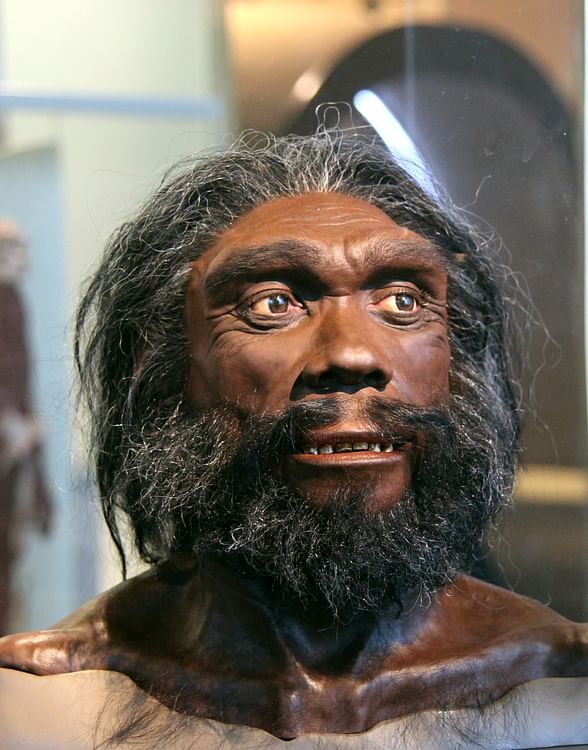
Homo heidelbergensis is an extinct species of human that is identified in both Africa and western Eurasia from roughly 700,000 years ago onwards until around 200,000 years ago – fitting snugly within the Middle Pleistocene. Named for a piece of jawbone found near Heidelberg, Germany, these hominins occupy an intriguing and much-discussed spot in the jumble of human evolution; they are most commonly seen to have developed from Homo erectus and to have given rise to Homo sapiens in Africa and to the Neanderthals in Europe. However, exactly how or why (and even if) this happened, is the subject of much debate, and the same goes for the precise definition of this species – for instance, which fossils should be included and which should not.
Following the general view, though, Homo heidelbergensis is recognised as a distinct species that was a bit more brainy and inventive than its predecessors; fairly complex tools are associated with them, allowing us to catch a glimpse of possibly quite daring hunting strategies involving larger prey animals, which hints at the potential presence of social cooperation.
DISCOVERY
In 1907 CE, the Grafenrain sandpit at the site of Mauer, near Heidelberg, Germany, became somewhat of a sensation as a robustly built jawbone of a previously unknown species of human was discovered there. After realising it had both some more primitive features as well as bits that reminded him of more recent human features, Otto Schoetensack assigned it to a distinct species he named Homo heidelbergensis in the following year. The jawbone has recently been dated to an age of around 600,000 years ago, which falls within the MIS 15 interglacial period and indicates that its owner would not have instantly frozen solid upon reaching this region.
HOMO HEIDELBERGENSIS WERE SOMEWHAT CHUNKIER VERSIONS OF OURSELVES; NOTICEABLY MORE ROBUST THAN US, BUT WITH A BRAIN SIZE ALMOST APPROACHING OUR OWN.
WHAT DID THEY LOOK LIKE?
If one was to stroll into a Middle Pleistocene cave inhabited by an average group of Homo heidelbergensis individuals, they would probably strike one as somewhat chunkier versions of ourselves; noticeably more robust than us, but with a brain size almost approaching our own – perhaps averaging somewhere around 1200 cm3 or upwards, which is markedly bigger than that of Homo erectus.
Although Heidelbergensis still had quite heavily constructed, broad faces reminiscent of Homo erectus, their brow ridges were less pronounced and their noses were more vertical like ours are, instead of sloping forward like those of Erectus. A skull from Bodo, Ethiopia, dated to approximately 600,000 years ago, is a good example of this mix of characteristics, and it can reasonably be grouped not just with other fossils from Africa, like those from Broken Hill in Zambia; Elandsfontein in South Africa; and Lake Ndutu in Tanzania; but also with individuals from Europe, such as those from Petralona in Greece, Arago in France, and generally also the mandible from Mauer, Germany.
Once the Middle Pleistocene fossil record decides to be a bit more generous, we may be able to more directly visualise the proposed development from Heidelbergensis into Sapiens in Africa and into Neanderthals in Europe. One possible example comes from the site of Boxgrove in England, Europe, which is usually assigned to Homo heidelbergensis and is thought to be around 500,000 years old. The tibia found there shows it was more robust than average Heidelbergensis specimens and indicates body proportions that were better adapted to the cold, foreshadowing those of the later Neanderthals.
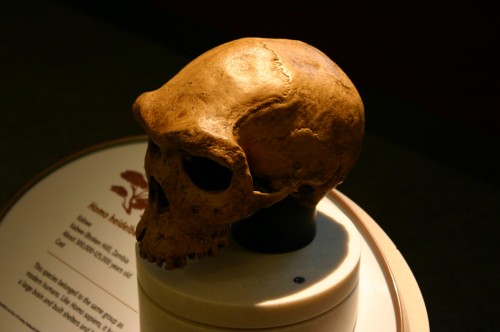
Homo Heidelbergensis Skull
LIFESTYLE
These humans were hunter-gatherers - some of them well-adapted to the generally more stable and warm African terrain;another branch skilled at weaving in and out of regions in Europe along with the growing and receding ice sheets. Obviously, these bands would not have shared the exact same customs down to a tee, but we can still paint something of a general picture, with some splashes of regional colour added.
Part of this general picture involves Heidelbergensis coming home from a fruitful hunt and sticking the day's catch over a neat fire. Preferred real estate came in the shape of caves, which during the Middle Pleistocene became both more spatially structured and dotted with hearths. Although a more incidental use of fire had been around since at least 1,8 million years ago, fire remained a rare sight up until the days of Homo heidelbergensis. During its timespan, Heidelbergensis became ever more accustomed to fire and its cooking potential; we know that by at least around 400,000 years ago, humans roaming across the Old World - including the colder north, where it was particularly useful – clearly used fire in a habitual way.
Fire is already a sign of a more advanced sort of lifestyle, and this image is further supported by the tools manufactured and used by Homo heidelbergensis. Their tool kits were more sophisticated than that of Homo erectus and belonged, in contrast to the latter's early Acheulean, to the later Acheulean industry. In general, the Acheulean is characterised by large bifaces like hand axes, picks and cleavers, whereas later Acheulean tools were thinner, more finely flaked, and more symmetrical.
HUNTING PROWESS
That the tools created by Homo heidelbergensis allowed them not just to process their food and work raw materials to a satisfactory standard, but also to become adept hunters climbing further up the food chain, seems to be suggested by certain finds. At the site of Boxgrove in England, dated to around 500,000 years ago, thin and extensively flaked flint bifaces have been found together with the remains of horses and rhinoceroses. Interestingly, the animal bones bear cut marks, indicating that these large animals seem to have been killed and butchered by Heidelbergensis.
At Schöningen in Germany, things become even more exciting; eight skilfully crafted wooden throwing spears have been found, created at least 300,000 years ago. The remains of numerous horses - many of their bones cut-marked - found in the same horizon, ties in with Boxgrove and seems to indicate that Heidelbergensis systematically hunted large animals. This is no easy feat; the manufacturing of the spears shows active planning, and bringing down these dangerous animals would have required coordination and sophisticated communication.
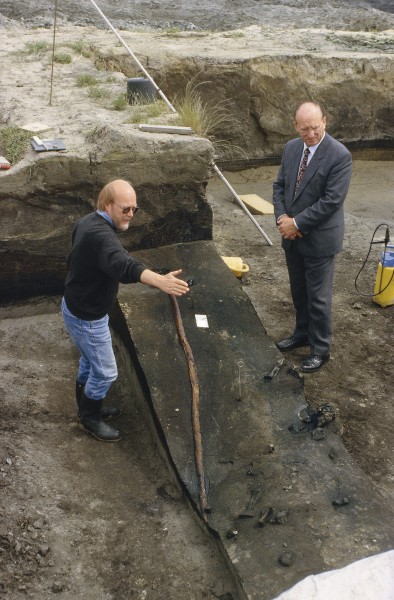
Homo Heidelbergensis Spear
The backdrop for these activities, then, hints at a social structure that may well have been more widespread. Although wood does not usually stand the test of time very well, Heidelbergensis ' stone tools show a similarly advanced nature across its range, and unless this specific region was somehow unique in its development wooden tools could have made up an important part of these people's prehistoric tool kits. If that were indeed the case, the social implications that have been suggested for the site of Schöningen are assumed to be valid across the breadth of the species. We may yet discover more evidence to shed light on this matter.
HEIDELBERGENSIS' PLACE WITHIN EVOLUTION
Since it can sometimes be hard to confidently lump an ambiguous fossil (of which there are plenty) into species such as Homo erectus, Homo heidelbergensis, or the Neanderthals, researchers have come up with all sorts of scenarios describing the place of Heidelbergensis within evolution. Sometimes, Heidelbergensis is scrapped altogether in favour of a more broadly defined Homo erectus ; sometimes Heidelbergensis is seen as an exclusively European lineage giving rise to the Neanderthals; and the more stubborn kind of fossils associated with Heidelbergensis seem hard-pressed to attain any kind of consensus.
AROUND 700,000 YEARS AGO HOMO HEIDELBERGENSIS DEVELOPED FROM HOMO ERECTUS.
However, so far the scenario best supported by both the anatomical and the genetic evidence, of which the general lines (although not always the details) are favoured by most people, is as follows. Around 700,000 years ago (and perhaps as early as 780,000 years ago), Homo heidelbergensis had developed from Homo erectus. In Africa, they were part of a gradual, mosaic -like transition into the earliest Homo sapiens around roughly 200,000 years ago. Finds from sites such as Omo Kibish, Ethiopia; Irhoud in Morocco; and Herto in the Middle Awash region seem to showcase this.
Populations of Heidelbergensis also spread through western Eurasia, appearing north of the major mountains of Europe sometime after 700,000 years ago. Clearly adapting well to the challenging environment, the cold conditions led them to evolve the specialised facial features and more stocky build of the Neanderthals, to whom they gave rise and who appear with clear and recognisable features from roughly 200,000 onwards. Of course, with this being a gradual process, the proposed timing is subject to a lot of bickering.
There is another group that also derives from Heidelbergensis, though. In 2008 CE, a human finger bone was found in the Denisova Cave in the Altai Mountains in Siberia that turned out to belong to a separate species dubbed the Denisovans.Genetic evidence has since revealed that they are a sister species to the Neanderthals, with these two groups diverging at some point after the Heidelbergensis lineages leading to Sapiens as well as the Neanderthals and Denisovans had split.

Stringer Graph-model of Homo Evolution
This new addition just makes it even clearer how complex an evolutionary story the Pleistocene really tells. Another confusing example is the fossils at the site of Sima de los Huesos in Spain. Generally grouped within Homo heidelbergensis, these fossils are at least 430,000 years old (and perhaps up to c. 530,000 years old) and already show some Neanderthal -like features, opening up the debate for them being considered proto-Neanderthals: Heidelbergensis on their way to eventually becoming Neanderthals. Interestingly, in 2014 mitochondrial DNA was retrieved from one of the Sima fossils which showed it was closely related to the lineage leading to the Denisovans - a sister group to the Neanderthals. It is clear that the Pleistocene was home to a complex story of human evolution.
Neanderthal › Antique Origins
Definition and Origins

Neanderthals are an extinct group of fossil humans that appeared in Western Eurasia in the mid-Middle Pleistocene and shared the stage with the first modern humans arriving in Europe from around 45,000 years ago, before disappearing from the fossil record between c. 40,000 - c. 30,000 years ago. Neanderthals were a highly successful group, having adapted well to the unpredictable climate of a region in which advancing and retreating ice sheets were no strangers. Their short, stocky build made them sturdy and powerful, while their large brains fuelled their capability of hunting even the biggest Ice Age creatures such as mammoths or woolly rhinoceros.
We – modern humans – are tied to Neanderthals in many ways, from sharing a common ancestor down the line, back in Africa, to coexisting in Europe for some time. There, the two must have competed for resources, but are also known to have interbred with each other, causing the Neanderthals to have had a genetic impact on us still visible in our DNA today.
DISCOVERY
When the first Neanderthal fossils were dug up in the early 19th century CE (Engis child in 1830 CE and Forbes Quarry adult in 1848 CE) they were not immediately recognized as a kind of archaic human. Instead, the skeletons' peculiar anatomy, which clearly differed from modern humans, was explained away as resulting from diseases such as rickets. However, after a skeleton was discovered in the Neander Valley in Germany in 1856 CE, the subsequent research was influenced by the publication of Darwin's On the Origin of Species in 1859 CE, and the ball began to roll. By 1864 CE the mysterious skeletons had been assigned to the species Homo neanderthalensis.
WHAT WE SEE AS “CLASSIC” NEANDERTHALS, WITH THE FULL SET OF FEATURES ASSOCIATED WITH THEM, DID NOT APPEAR UNTIL AROUND 70,000 YEARS AGO.
WHEN & WHERE DID THEY LIVE?
Owing to the difficulties that the process of evolution adds to the classification of species, there is no clear-cut date for the initial appearance of Neanderthals. Rather, we recognise that the first Neanderthal-like features appeared between c. 600,000- c. 400,000 years ago, with a progressively stronger expression of their morphology developing throughout time. Between 200,000 and 100,000 years ago their features are clear and recognisable, although what we see as “classic” Neanderthals, with the full set of features associated with them, did not appear until around 70,000 years ago.
Neanderthals share a common ancestor with modern humans in Africa, between c. 550,000 and c. 750,000 years ago. They are usually identified as Homo heidelbergensis, although a 2016 CE study suggests a divergence date for Neanderthals so far back in time it rules them out, and instead proposes Homo antecessor as the best candidate. Whoever it may have been, a group of this common ancestor species migrated into Europe, where it evolved not only into the Neanderthals but also into their sister group, the Denisovans. The common ancestor group that remained in Africa evolved into homo sapiens.

Geographical Range of Neanderthals
Neanderthals were very widespread: specimens have been found ranging from Spain and the Mediterranean to Northern Europe and Russia, as well as throughout the Near East, and as far east as Uzbekistan and Siberia.
NEANDERTHAL MORPHOLOGY
Considering the fact that Neanderthals evolved from their predecessor in Ice Age Western Eurasia and lived there for such a length of time, they needed to be well-adapted to the often cold climate. Short and stocky, with males averaging around 169 cms and females around 160 cms tall, and sporting broad and deep ribcages, Neanderthals had a different build than the taller and lankier modern humans. Their heavy brow ridges, large faces with appropriately large noses, and lack of chin further set them apart.
Otherwise, Neanderthals share a whole host of derived features with modern humans, among which are enlarged brains (their brain cases were even larger than ours), and they also had less of a protruding face than many earlier archaic humans.Regarding hair and skin colour, Neanderthals likely had high variability – certainly higher than the arriving modern humans.Pale skin and red hair are suggested by the DNA from two specimens from Italy and Spain, whereas darker skin and brown or red hair are indicated in three individuals from Vindija, Croatia.
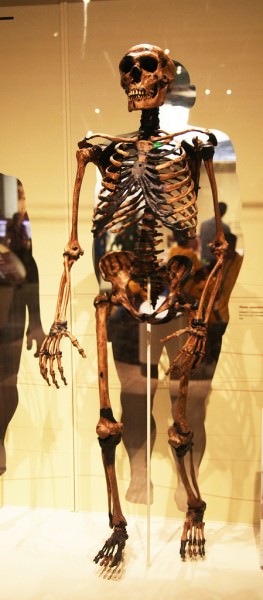
Neanderthal Adult Male Skeleton
The fossil record also betrays that Neanderthals were anything but pushovers; they led harsh and dangerous lives. Almost all well-preserved adult skeletons show some sign of trauma, usually around the head or neck region, perhaps related to hunting strategies in which they had to come close to large prey animals. The fact that the majority of these lesions had healed or partially healed means that the individuals in question were socially cared for and recovered from their injuries to hunt another day. However, not everyone was that lucky; on average, Neanderthal adult life expectancy was very low, clearly owing to the physically stressful and dangerous nature of their lives.
LIFESTYLE
Both the powerful build and amount of trauma seen in Neanderthals indicate they were active hunters, and what we know about the high reliance on meat in their diet ties in with the amount of energy hunting would have required. They ate mostly herbivore meat, from mammals such as bison, wild cattle, reindeer, deer, ibex and wild boar. Interestingly, the very largest of the Ice Age herbivores, woolly mammoths and woolly rhinoceros, actually represent a large part of the Neanderthal diet. It would have been no mean feat to bring these animals down, even for a coordinated group of skilled hunters – which the Neanderthals would have been. Besides meat there was also a strong plant component to their diet, most likely consisting of legumes and grasses, seeds and fruits. Moreover, it is clear that Neanderthals cooked their food and maybe even knew medicinal uses of plants.
As far as the tools Neanderthals used, they are most commonly (but not exclusively) associated with Mousterian lithic technology. Flint flakes were turned into side scrapers, retouched points, and small hand-axes, usually from locally available material. Very few bone tools are known, but wooden tools were most likely used, too. From at least 200,000 years ago Neanderthals had the ability to control fire, when we know it was used as a tool to produce birch-bark pitch, although they likely used it much earlier already, as controlled use of fire appeared throughout Europe from 400,000 years ago onward.
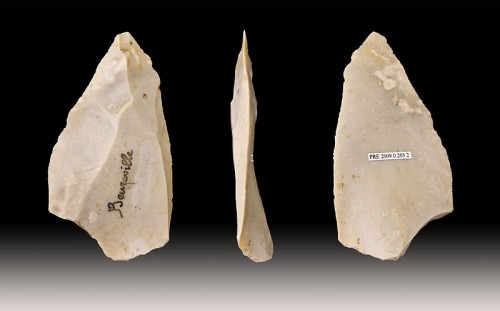
Neanderthal Tools - Levallois Point
Not big on building their own structures (although exceptions are known), their fires would predominantly have lit caves or other natural shelters, in which the living areas that have been found are relatively small and a bit chaotic, showing no clear focus of activity. Hearths are well defined, though, and probably played a central role not just with regard to cooking or warmth but also for tool production.
Traditionally, Neanderthals were depicted as cognitively inferior to the arriving modern humans, with a less sophisticated culture and lack of symbolic thought that would have given our ancestors the edge. However, this image has now been overturned; Neanderthals were clearly a complex group. Besides coordinated hunting (for which effective communication is needed), caring for their wounded, advanced use of fire and tool production, Neanderthals have been known to intentionally bury their dead. Moreover, stalagmite rings built by the Neanderthals in Bruniquel cave in France, dated to 176,500 years ago, show planning, control of the underground environment, and perhaps symbolic use. They also perforated and coloured marine shells, and, strikingly, seem to have used red ochre at a site in Maastricht-Belvedère as early as a stunning 200,000-250,000 years ago, drawing it level with the time range documented for the African record for the use of ochre. These were no simple brutes, and their disappearance cannot be explained away by a large perceived gap in intelligence between our species.
DISAPPEARANCE
Around 55,000 years ago, the main wave of modern humans that had left Africa met the Neanderthals in the Near- and Middle East, where they interbred. Modern humans then spread across Eurasia, reaching Europe at the earliest around 45,000 years ago. They came in much larger numbers, both in group size and overall population density, than the present Neanderthals, who suddenly faced competition for resources. Soon after, between c. 40,000 and c. 30,000 years ago, the Neanderthals vanished from the fossil record.

Shanidar Cave, Kurdistan, Iraq
Besides competition, another factor that may have played a role in the Neanderthals' disappearance is the climate, which was much more unstable around that time than previously recognised. This may have stressed their population, which was already many times smaller than the invading modern humans' numbers, leaving them vulnerable to their impact.
Moreover, interbreeding with Neanderthals helped modern humans adapt to the colder climate in Europe, as their genes impacted our skin colour and hair. Due to our ancestors mixing with Neanderthals after leaving Africa, in total, non-African humans possess on average around ~2% Neanderthal DNA. However, the two groups were clearly only on the cusp of biological compatibility, as research has shown that interbreeding led to decreased fertility as well as miscarriages when male babies possessed a Neanderthal Y chromosome. This would have decreased the total Neanderthal genetic contribution. When combining this with the vast difference in population sizes between the two groups, it may suggest interbreeding played a significant part in explaining why Neanderthals vanished – perhaps they were partially 'absorbed' into our population. In the end, the Neanderthals' disappearance must have come down to a combination of many different factors, including vast competition, the harsh environment, as well as some measure of interbreeding. We are only beginning to uncover the exact details of the genetic influence they had on us, though, so we are definitely not done with them yet.
LICENSE:
Article based on information obtained from these sources:with permission from the Website Ancient History Encyclopedia
Content is available under License Creative Commons: Attribution-NonCommercial-ShareAlike 3.0 Unported. CC-BY-NC-SA License